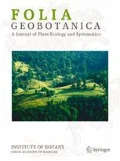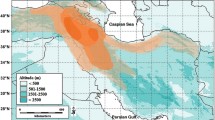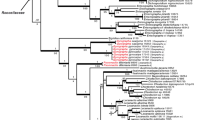Abstract
A first attempt to establish the phylogeny of the generaEchinops andAcantholepis has been carried out using the analysis of the internal transcribed spacers (ITS) sequences of the nuclear ribosomal DNA including 30Echinops species and the only species of the monotypicAcantholepis. The results of this analysis are discussed in the light of morphological and cytogenetic characters. The genusAcantholepis is placed in a robust clade withEchinops nanus, and together they appear in a basal position to other members ofEchinops. The ITS phylogeny and several other characters, such as chromosome number and nuclear DNA amount, do not agree with the sections currently recognized withinEchinops. Some groups are defined in the present approach, but further studies are necessary to reach a complete, stable and natural infrageneric classification of this genus.
Similar content being viewed by others
References
Álvarez I. &Wendel J.F. (2003): Ribosomal ITS sequences and plant phylogenetic inference.Molec. Phylogenet. Evol. 29: 417–434.
Bentham G. (1873):Compositae. In:Bentham G. &Hooker J.D. (eds.),Genera plantarum 2, Reeve and Co., London, pp. 163–533.
Bennett M.D. (1972): Nuclear DNA amount and minimum generation time in herbaceous plants.Proc. Roy. Soc. London B 191: 109–135.
Bremer K. (1988): The limits of amino acid sequence data in angiosperm phylogenetic reconstruction.Evolution 42: 795–803
Bremer K. (1994): Asteraceae:Cladistics and classification. Timber Press, Portland.
Candolle A.P. (1837):Prodromus systematis naturalis regni vegetabilis 6. Treuttel et Würtz, Paris.
Davis P.H. (ed.) (1975):Flora of Turkey and the East Aegean Islands 5. University Press, Edinburgh.
Dimitrova D. &Greilhuber J. (2000): Karyotype and DNA-content evolution in ten species ofCrepis (Asteraceae) distributed in Bulgaria.Bot. J. Linn. Soc. 132: 281–297.
Dittrich M. (1977):Cynareae-Systematic review. In:Heywood V.H., Harborne J.B. &Turner B.L. (eds.),The biology and chemistry of the Compositae 2, Academic Press, London, pp. 999–1015.
Dittrich M. (1996): Die Bedeutung morphologischer und anatomischer Achänen-Merkmale für die Systematik der TribusEchinopeae Cass. undCarlineae Cass.Boissiera 51: 9–102.
Doyle J.J. &Doyle J.L. (1987): A rapid DNA isolation procedure for small quantities of fresh leaf tissue.Phytochem. Bull. 19: 11–15.
Felsenstein J. (1985): Confidence limits on phylogenies: An approach using the bootstrap.Evolution 39: 783–791.
Garcia S., Sanz M., Garnatje T., Kreitschitz A., McArthur E.D. &Vallès J. (2004): Variation of DNA amount in 47 populations of the subtribeArtemisiinae and related taxa (Asteraceae, Anthemideae): karyological, ecological, and systematic implications.Genome 47: 1004–1014.
Garcia-Jacas N., Garnatje T., Susanna A. &Vilatersana R. (2002): Tribal and subtribal delimitation and phylogeny of theCardueae (Asteraceae): a combined nuclear and chloroplast DNA analysis.Molec. Phylogenet. Evol. 22: 51–64.
Garnatje T., Vallès J., Garcia S., Hidalgo O., Sanz M., Canela M.A. &Siljak-Yakovlev S. (2004a): Genome size inEchinops L. and related genera (Asteraceae, Cardueae): karyological, ecological and phylogenetic implications.Biol. Cell 96: 117–124.
Garnatje T., Vilatersana R., Susanna A., Vallès J. &Siljak-Yakovlev S. (2004b): Contribution to the karyological knowledge ofEchinops L. (Asteraceae, Cardueae) and related genera.Bot. J. Linn. Soc. 145: 337–344.
Greuter W. (2003): The Euro+Med treatment ofCardueae (Compositae) — generic concepts and required new names.Willdenowia 33: 49–61.
Hoffmann O. (1894):Compositae. In:Engler A. &Prantl K. (eds.),Die natürlichen Pflanzenfamilien, Engelmann, Leipzig, vol. 4, pp. 87–387.
Jäger E.J. (1987): Arealkarten derAsteraceen-Tribus als Grundlage der ökogeographischen Sippencharakteristik.Bot. Jahrb. Syst. 108: 481–497.
Kit Tan K. (1995): Seven new species ofEchinops (Asteraceae).Ann. Bot. Fenn. 32: 117–126.
Kožuharov S. (1976):Echinops L. In:Tutin et al. (eds.),Flora Europaea 4, Cambridge University Press, Cambridge, pp. 212–214.
Kruse J. &Meusel H. (1972): Zur Blattfolge und Blattbildung einiger Cynareen-Gattungen. 2.Acantholepis, Xeranthemum, Chardinia, Siebera, Amphoricarpos. Feddes Repert. Spec. Nov. Regni Veg. 83: 289–308.
Leitch I.J., Chase M.W., Bennett M.D. (1998): Phylogenetic analysis of DNA C-values provides evidence for a small ancestral genome size in flowering plants.Ann. Bot. (Oxford) 82: 85–94.
Maddison D.R. (1991): The discovery and importance of multiple islands of most parsimonious trees.Syst. Zool. 40: 315–328.
Mehra P.N., Gill B.S., Mehta J.K. &Sidhu S.S. (1965): Cytological investigations on the IndianCompositae. I. North-Indian taxa.Caryologia 18: 35–68.
Morgan D.R. (1997): Decay analysis of large sets of phylogenetic data.Taxon 46: 509–517.
Moore R.J. (1973): Index to plant chromosome numbers 1967–1971.Regnum Veg. 90.
Murray B.G., Cameron E.K. &Stardring L.S. (1992): Chromosome numbers, karyotypes, and nuclear DNA variation inPratia Gaudin (Lobeliaceae).New Zealand J. Bot. 30: 181–187.
Nickrent D.L., Schuette K.P. &Starr E.M. (1994): A molecular phylogeny ofArceuthobium (Viscaceae) based on nuclear ribosomal DNA internal transcribed spacer sequences.Amer. J. Bot. 81: 1149–1160.
Ohri D. (1996): Genome size and polyploidy variation in the tropical hardwood genusTerminalia (Combretaceae).Pl. Syst. Evol. 200: 225–232.
Petit D.P. (1988): Le genreEchinops L. (Compositae, Cardueae). 1. Position phylétique et interprétation de l’incapitulescence.Candollea 43: 467–481.
Petit D.P. (1997): Generic interrelationships of theCardueae (Compositae): A cladistic analysis of morphological data.Pl. Syst. Evol. 207: 173–203.
Petit D.P., Mathez J. &Qaid A. (1996): Early differentiation of theCardueae sensu lato, morphology and pollen. In:Hind D.J.N. &Beentje H.J. (eds.),Compositae: Systematics. Proceedings of the International Compositae Conference 1, Kew, 1994, Royal Botanic Gardens, Kew, pp. 79–93.
Pignatti S. (ed.) (1982):Flora d’Italia 3. Edagricole, Bologna.
Rechinger K.H. (ed.) (1979):Flora des Iranischen Hochlandes und der umrahmenden Gebirge. CompositaeIII — Cynareae. Akademische Druck-u. Verlagsanstalt, Graz.
Shishkin B.K. & Bobrov E.G. (eds.) (1997):Flora of the USSR 27. Bishen Singh, Mahendra Pal Singh and Koeltz Scientific Books, Dehra Dun.
Soltis D.E., Soltis P.S., Collier T.G. &Edgerton M.L. (1991): TheHeuchera group (Saxifragaceae): Evidence for chloroplast transfer and paraphyly.Amer. J. Bot. 78: 1091–1112.
Susanna A. &Garcia-Jacas N. (2005): The tribeCardueae. In:Kubitzki J. (ed.),The families and genera of vascular plants, Springer-Verlag, Heidelberg (in press).
Swofford D.L. (1999):PAUP*. Phylogenetic analysis using parsimony (* and other methods). Version 4. Sinauer, Sunderland.
Tomšovic P. (1997): Some palynological observations on the genusEchinops (Asteraceae) and their taxonomic implications.Preslia 69: 31–33.
Valdés B. (1996): Tres nuevas combinaciones enAsteraceae.Lagascalia 18: 306.
White T.J., Bruns T., Lee S. &Taylor J. (1990): Amplification and direct sequencing of fungal ribosomal RNA genes for phylogenetics. In:Innis M., Gelfand D., Sninsky J. &White T. (eds.),PCR protocols: A guide to methods and applications, Academic Press, San Diego, pp. 315–322.
Author information
Authors and Affiliations
Corresponding author
Rights and permissions
About this article
Cite this article
Garnatje, T., Susanna, A., Garcia-Jacas, N. et al. A first approach to the molecular phylogeny of the genusEchinops (Asteraceae): Sectional delimitation and relationships with the genusAcantholepis . Folia Geobot 40, 407–419 (2005). https://doi.org/10.1007/BF02804288
Received:
Revised:
Accepted:
Issue Date:
DOI: https://doi.org/10.1007/BF02804288




